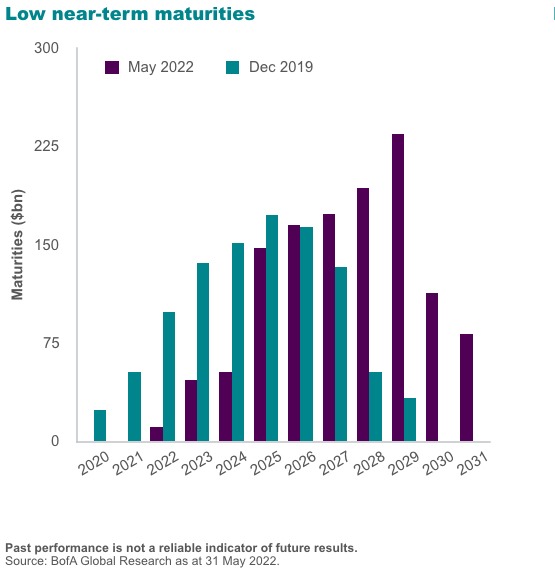By Azhar Hussain, Head of Global Credit at Royal London Asset Management
Global high yield credit isn’t for everyone, yet we feel that more investors should consider the benefits of this asset class given the considerable yield attractions. The market has evolved hugely over the last 15 years and is now much higher quality than in the early 2000s or during the Global Financial Crisis. And Covid gave companies the opportunity to issue new debt or refinance their existing credits at ultra-low interest rates, meaning that issuers are in particularly good health for this stage of the cycle. Furthermore, the risks can be mitigated with an active and disciplined investment process.
Surely now is not the time to make this argument, though – with central banks hiking interest rates to try to chase down inflation and risking recession over the next 12 months? The combination of the higher- and stickier-than-expected inflation that started to become apparent towards the end of last year and the Russian invasion of Ukraine that has pushed up commodities prices sharply has accelerated the need for higher interest rates. Where we might have been able to accommodate the initial inflation risks, we became more bearish with the ‘double whammy’ that has impacted fixed income markets in particular this year.
In theory, a slowdown would not be good news for global high yield, particularly if it’s a hard landing – it would increase the risk of defaults and this is a key driver for high yield credit. The high yield market is somewhat unsophisticated in its approach to defaults – it prices the possibility of defaults off previous cycles with no real consideration of the state of the prevailing market.
Default risk is overvalued
With high yield spreads at 490 basis points (bps) at the end of May, the implied cumulative (5 year) default rate for the possible impending recession is 20%. This compares to actual cumulative default rates of 25% during the Global Financial Crisis and 30%+ in the 1990s and early 2000s.The all-time high was 41% in the long and deep depression of the 1930s. So, the high yield market is discounting a major recession and a commensurate level of defaults.
Yet this takes no account of the much higher quality and more robust nature of the high yield market today, even compared to 2008/9; nor of the current financial state of the issuers as we head towards the probable downturn. The global high yield market is much larger, having grown from $1trn to $2.5trn since 2009: meanwhile, issuers are bigger and better quality, and the spread of sectors is more stable. The average issuance has increased from $400m to $700m. At the same time, the average coupon rate is significantly lower, making it easier for issuers to service their debt.
On top of this qualitative improvement, there are some additional factors to note. The impact of Covid-19 was undoubtedly positive as companies had a sustained opportunity to issue credits at ultra-low interest rates. Following the initial impact of the pandemic and the swift intervention of the Federal Reserve and other central banks, companies issued around $1trn of high yield debt (representing 40% of the total market) and this has significantly pushed out the maturity wall.

Furthermore, energy remains one of the key sectors in high yield: the sector has been turbo-boosted by the recovery in prices since economies reopened and subsequently by the sanctions imposed on Russia following the Ukraine invasion. Given the inherent asymmetry of credit investing, this isn’t an E&P equities-style bonanza for high yield. However, it is a useful tailwind for the asset class as we head towards a recession.
Given these factors – overall market quality, Covid-driven refinancings and the relative strength of the energy sector, in particular – we feel strongly that valuations for global high yield currently overvalue defaults and therefore there is good protection available for investors. For investors who might feel that the risks are nonetheless still too high given the macroeconomic uncertainty, the front-end of the high yield market mitigates these risks as it is within a forecastable period. Shorter-duration funds offer some of the upside while providing protection from more extreme macroeconomic or duration risks.
Why RLAM?
You may know Royal London Asset Management (RLAM) as a sterling investment grade specialist. That is indeed our heritage, but we’ve developed considerably over the last decade and have a number of other areas of expertise. The Global Credit team has been at RLAM since 2012 and has since expanded to four fund managers and 10 analysts (and counting). We’ve been managing the same strategy, in the same way, since 2002 – it’s tried and tested with a 20-year record.
Our investment process focuses on default avoidance and credit loss reduction. Global high yield offers the broadest universe and such an opportunity set allows us to diversify across markets and sectors, yet avoid higher risk issuers. By taking an active and selective approach, with an emphasis on liquidity, we aim to simplify the process of identifying which credits to buy and retain. We seek to analyse and value risk, rather than speculate on uncertainty.
The recovery rate in global high yield is c. 40%, but we would rather exit a position early rather than incur losses by waiting. As a result, we’ve never had a loss via a default nor a substantial credit loss by selling in our short-dated strategy. Even in 2008, our worst, and so far only negative, year for performance, we delivered only a -3.5% return (when the high yield market return was -27%).
In conclusion
To sum up, sharply higher yields mean global credit offers investors a significant buffer against the travails of a potential recession. Given the moves since January, we feel the market is now overcompensating investors for the potential default risks, given the structural evolution of the market over the last 20 years and specific factors such as Covid-driven refinancings and high energy prices. Canny investors can reap the benefit of this without taking on unnecessary macroeconomic or duration risk by considering active short duration global high yield strategies operating at the front end of the curve.
If this sounds interesting or you’d like to know more about how the global high yield market has changed, we would be delighted to talk to you.
Royal London Asset Management (RLAM) has partnered with FundRock distribution S.A, who will distribute RLAM’s products and services in the EEA. This follows the United Kingdom’s withdrawal from the European Union and ending of the subsequent transition period, as UK Financial Services firms, including RLAM, can no longer passport their business into the EEA.
For more information contact: info_frd@fundrock.com
Investment Risks:
Past performance is not a guide to future performance. The value of investments and any income from them may go down as well as up and is not guaranteed. Investors may not get back the amount invested. The views expressed are those of the author at the date of publication unless otherwise indicated, which are subject to change, and is not investment advice.
For Professional Clients only, not suitable for Retail Clients.
This marketing material is a financial promotion and is not investment advice. Telephone calls may be recorded. For further information please see the Privacy policy at www.rlam.com.
Issued in June 2022 within Europe (ex-Switzerland) by FundRock Distribution S.A. (“FRD”) the EU distributor for Royal London Asset Management Limited. FRD is a public limited company, incorporated under the laws of the Grand Duchy of Luxembourg, registered office at 9A, rue Gabriel Lippmann, L-5365 Munsbach, Luxembourg, and registered with the Luxembourg trade and companies register under number B253257. Page 23, FRD is authorized as distributor of shares/units of UCIs without making or accepting payments (within the meaning of Article 24-7 of the 1993 Law), as updated from time to time. FRD is authorised and regulated by the Commission de Surveillance du Secteur Financier (CSSF). Portfolio management activities and services are undertaken by Royal London Asset Management Limited, 55 Gracechurch Street, London, EC3V 0RL, UK. Authorised and regulated by the Financial Conduct Authority in the UK, firm reference number 141665. A subsidiary of The Royal London Mutual Insurance Society Limited.



